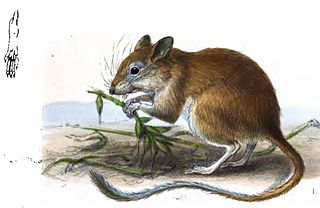The Berbera gerbil is a species of rodent in the subfamily Gerbillinae. It is endemic to Somalia.

The Balochistan gerbil or dwarf gerbil, is distributed mainly from Morocco across north Africa, the Arabian Peninsula, the Middle East, and western Asia. This is a common species with a wide distribution which faces no obvious threats, so the International Union for Conservation of Nature has rated its conservation status as being of "least concern".

The lesser Egyptian gerbil is a small species of rodent in the family Muridae. It is native to North Africa and the Sinai Peninsula, where it lives in sandy habitats. It is a common species, and the International Union for Conservation of Nature has rated its conservation status as being of "least concern".

Tarabul's gerbil is a species of small rodent which is found in arid regions of north western Africa.
The Western Saharan spiny mouse or Aïr spiny mouse is a species of small, insectivorous rodent in the family Muridae found arid regions of western Africa.

The North African gerbil is a species of rodent in the family Muridae. It is found in North Africa where its natural habitats are arable land and rocky areas of the Maghreb, and hot Saharan deserts.
The Namib brush-tailed gerbil or Setzer's hairy-footed gerbil is a species of rodent endemic to Angola and Namibia. Its natural habitats are sandy and gravelly plains. It stays in its burrow by day, emerging at night to feed on arthropods, vegetable matter, and seeds.
Mittendorf's lemniscomys or Mittendorf's striped grass mouse is a species of rodent in the family Muridae. It is endemic to Cameroon where it is found at high elevations on a single mountain. Its natural habitat is tropical high-altitude grassland. It faces no particular threats and the International Union for Conservation of Nature has listed it as being of "least concern".
The Ethiopian white-footed mouse or white-footed stenocephalemys is a species of rodent in the family Muridae. It lives in Ethiopia and Eritrea. Its natural habitats are tropical moist montane forest and tropical high-altitude shrubland.
The gracile tateril or slender gerbil is a species of rodent found in Burkina Faso, Chad, Gambia, Ghana, Guinea, Ivory Coast, Mali, Niger, Nigeria, Senegal, Togo, and possibly Cameroon. Its natural habitats are dry savanna, arable land, pastureland, and rural gardens. It is a common species, sometimes considered an agricultural pest, and the International Union for Conservation of Nature has rated its conservation status as being of "least concern".

The Asian garden dormouse or large-eared garden dormouse, is a species of rodent in the family Gliridae. It is found in Egypt, Iraq, Israel, Jordan, Lebanon, Libya, Saudi Arabia, Syria and Turkey. Its natural habitats are temperate forests, subtropical or tropical dry shrubland, Mediterranean-type shrubby vegetation, rocky areas and gardens.

Hildegarde's shrew is a recently discovered shrew, described in 1904. Considered by some authorities to be a subspecies of the Peters's musk shrew, it is now recognised as a separate species, with a diploid chromosome number of 2n = 52.

The swamp musk shrew, or musk shrew, is a species of mammal in the family Soricidae. It occurs in Angola, Botswana, Democratic Republic of the Congo, Mozambique, Namibia, South Africa, Eswatini, Zambia and Zimbabwe. Its natural habitat is swamps, and it is a common species in suitable habitats, with the International Union for Conservation of Nature listing it as being of "least concern".

The Ugandan musk shrew is a species of mammal in the family Soricidae. It is found in Uganda, the Democratic Republic of Congo and the Central African Republic. Its range, population size and habits are poorly known.

The black-footed shrew is a species of mammal in the family Soricidae. It is endemic to northern and central Sulawesi, Indonesia where it lives on the floor of the tropical forests. The International Union for Conservation of Nature has assessed its conservation status as being of "least concern".

The African giant shrew is a species of white-toothed shrew. It also is known as, Mann's musk shrew, Euchareena's musk shrew, or Olivier's shrew. It is native to Africa, where it has a widespread distribution and occurs in many types of habitat. Its natural habitats are subtropical or tropical dry forest, subtropical or tropical moist lowland forest, subtropical or tropical moist montane forest, dry savanna, moist savanna, arable land, rural gardens, urban areas, and heavily degraded former forest. In the Nile Valley it is found near human habitation, where it is considered to be a pest. It is a common species and is listed by the International Union for Conservation of Nature as being of "least concern".

The Egyptian pygmy shrew or sacred shrew is a species of mammal in the family Soricidae. It is endemic to Egypt. Its natural habitat is arable land. It is threatened by habitat loss, partially caused by the construction of the Aswan Dam. They are 48–62 mm (1.9–2.4 in) in length and weigh 7 g (0.25 oz), making them one of the smallest shrews in Egypt.

The Sulawesi white-handed shrew or Temboan shrew is a species of mammal in the family Soricidae. It is endemic to the island of Sulawesi in Indonesia. It is a fairly common species and the population seems stable so the International Union for Conservation of Nature has assessed its conservation status as being of "least concern".

The long-tailed forest shrew, or long-tailed mouse shrew, is a species of mammal in the family Soricidae. It is endemic to South Africa, where its natural habitats are Mediterranean-type shrubby vegetation and swamps.

The Maghreb garden dormouse is a nocturnal species of rodent in the family Gliridae. It is found in Algeria, Libya, Morocco, Tunisia and Western Sahara. Its natural habitats vary from humid forests to semi-deserts. It is a common species and the International Union for Conservation of Nature has rated it as being of "least concern".















